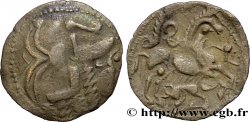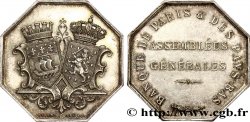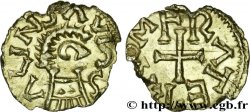fwo_759087 - ÉTATS-UNIS D'AMÉRIQUE 1 Dollar Morgan 1879 San Francisco
无库存.
所有在网站上销售的产品 (2023)
价格 : 140.00 €
所有在网站上销售的产品 (2023)
价格 : 140.00 €
种类 1 Dollar Morgan
日期: 1879
铸币厂名称/城市 San Francisco
铸币数量 9110000
材质 silver
纯度、成色(用角密度) 900 ‰
直径 38,10 mm
模子方针 6 h.
重量 26,73 g.
侧面 cannelée
正面
正面的文字 E . PLURIBUS . UNUM // 1879.
正面的说明书 tête à gauche de femme symbolisant la Liberté.
正面的翻译 (De plusieurs, un).
背面
背面的文字 UNITED - STATES OF - AMERICA // * ONE DOLLAR *.
背面的说明书 aigle aux ailles déployées tenant une branche d’olivier et deux flèches ; couronne de laurier et motto “In God we trust”.
背面的翻译 (États-Unis d’Amérique // un dollar).
评论
En 1873, le « Fourth Coinage act » met fin au bimétallisme et les monnaies en argent sont démonétisées. Cependant dès 1876, de nombreux projets de lois sont proposés afin de réintroduire des dollars en argent. En 1878, Rutherford B. Hayes tente en vain de faire véto au «Bland-Allison Act » au Congrès. Dans cette optique, dès 1876, Henry Linderman, directeur de l'US Mint demande alors à C.W. Fremantle, deputy master de la Royal Mint de Londres, de lui trouver un graveur de coin de premier rang. Ce sera Georges T. Morgan (1845-1925) qui devient assistant graveur auprès du graveur en chef William Barber. Dès 1877, Morgan travaille sur des essais monétaires et prépare son projet de dollar argent. Ainsi en 1878, seulement une semaine après le passage de la loi, l'atelier de Philadelphie frappe des dollars dits « Morgan ». Georges T. Morgan Morgan succèdera à Charles E. Barber (fils de William Barber) en 1917.
In 1873, the Fourth Coinage Act ended bimetallism, and silver coins were demonetized. However, as early as 1876, numerous bills were proposed to reintroduce silver dollars. In 1878, Rutherford B. Hayes unsuccessfully attempted to veto the Bland-Allison Act in Congress. With this in mind, Henry Linderman, director of the U.S. Mint, asked C.W. Fremantle, deputy master of the Royal Mint in London, to find him a top-tier coin engraver. This turned out to be George T. Morgan (1845–1925), who became assistant engraver to chief engraver William Barber. Starting in 1877, Morgan worked on coin trials and prepared his design for a silver dollar. Thus, in 1878, just one week after the passage of the Act, the Philadelphia Mint struck dollars known as \\\"Morgan dollars.\\\" Georges T. Morgan Morgan succeeded Charles E. Barber (son of William Barber) in 1917
In 1873, the Fourth Coinage Act ended bimetallism, and silver coins were demonetized. However, as early as 1876, numerous bills were proposed to reintroduce silver dollars. In 1878, Rutherford B. Hayes unsuccessfully attempted to veto the Bland-Allison Act in Congress. With this in mind, Henry Linderman, director of the U.S. Mint, asked C.W. Fremantle, deputy master of the Royal Mint in London, to find him a top-tier coin engraver. This turned out to be George T. Morgan (1845–1925), who became assistant engraver to chief engraver William Barber. Starting in 1877, Morgan worked on coin trials and prepared his design for a silver dollar. Thus, in 1878, just one week after the passage of the Act, the Philadelphia Mint struck dollars known as \\\"Morgan dollars.\\\" Georges T. Morgan Morgan succeeded Charles E. Barber (son of William Barber) in 1917









 对产品描述纠错
对产品描述纠错 打印
打印 分享我的选择
分享我的选择 提问
提问 Consign / sell
Consign / sell
 产品介绍
产品介绍








